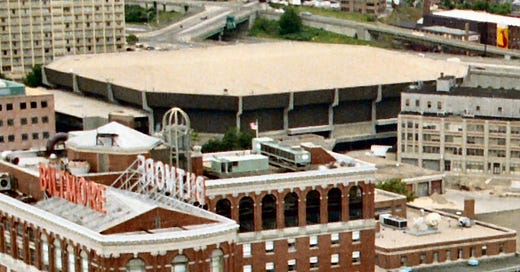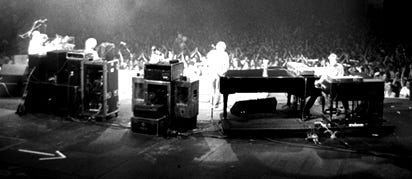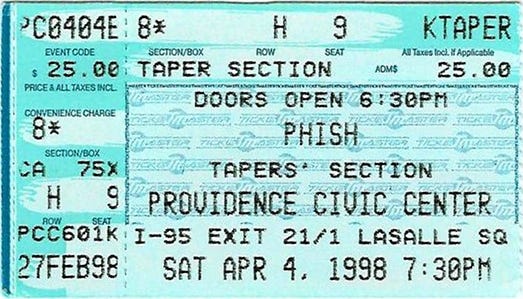SET 1: Tweezer > Taste, Bouncing Around the Room, Funky Bitch, Ginseng Sullivan, Limb By Limb, Lawn Boy, Character Zero
SET 2: Birds of a Feather > Also Sprach Zarathustra > Brother, Ghost -> The Lizards, David Bowie
ENCORE: Harry Hood
Listen on phish.in or Spotify.
In all the hyperbole of my first two posts this year, I’ve glossed over a less rose-tinted aspect of 1998: it’s the year that Phish and the surrounding scene started to significantly darken. Over the last four years we’ve gone over fan riots, aggressive band behavior, and bad-trip shows in this very venue. But the vibes have stayed predominantly light through the middle-90s, with Phish navigating through the wobbly process of assimilating the post-Jerry refugees and coming out the other side with nowhere near the traveling clusterfuck of the Dead’s final years.
Yet around this time, cracks begin to appear. Without getting tangled up in salacious rumors and hearsay, I think we can stipulate that Phish started partying way harder in the 1997-2000 period – stories of the backstage “Betty Ford Clinic” are public record, and the seeds of their eventual, temporary dissolution were indubitably planted in this span. Having reached the top of their field, Phish felt they could ease off the singular focus and practice that filled up all their on-tour free time their first 15 years, nudging a troublesome snowball into motion.
Meanwhile, the lot picked up some ugly elements, less from the Deadhead migration than from surprising new overlaps with the emergent late 90s U.S. rave scene and its expanded menu of pharmaceutical options. There are palpable differences between an atmosphere fueled by pot and acid and one laced with molly, ketamine, and opiates, and it transformed the flavor both outside and inside the venues. Hanging over it all – and usually forgotten in today’s burst of 90’s nostalgia – was a cloud of pre-millennial dread; you didn’t have to be a death cult member to feel like the world was hurtling towards a round-numbered inflection point.
These mood shifts couldn’t help but spill over into the music as well. The sonic changes we’ve discussed the last two days suit this transformation – the breakdown of traditional jam structures, the transition from familiar, “organic” 70s sounds and genres to more synthetic post-punk and electronic 80s aesthetics, the emphasis on texture and repetition over the big windmilling climax. I don’t know for sure that this style sounded better on the new drugs coming into the scene – I was resolutely sober at shows in the 90s – but I imagine it would.
No song better represents this progression than Birds of a Feather, the most significant debut of the Island Tour. BOAF came racing out of the gate, with two excellent, extended versions in public and a third played in private that you can hear on the SBDs (with bonus Fishman vocal practice). The song was obviously the bastard offspring of the Halloween ‘96 Remain in Light cover, built on itchy chords and elongated backing vocals ripped from the Talking Heads cookbook. And here, before it was sanded down in the studio and started wearing out its welcome in summer and fall, BOAF glides magnificently upon the embryonic ‘98 style, with Trey spending most of his time on rhythm guitar and loops, enabling full-band jamming with a menacing insistence.
Yet despite the thrill of its fully formed arrival, fans couldn’t help but notice that, lyrically, BOAF was…kinda rude? In an even more cynical sequel to Down with Disease, Tom Marshall offers a description of what seems pretty likely to be Phish fans from the perspective of a condescending and/or frightened anthropologist (or local newspaper rock critic): whippets dancing curly-queue, campfire chants, and inescapable ritual drumming. But most biting is the send-off:
It's not an experience if they can't bring someone along
They hang on emotions they bottle inside
They peck at the ground
And they strut out of stride
It’s a skewering of the Phish community’s pretensions towards being a counterculture that’s all the more harsh for being pretty on the button. Perhaps the Phish scene didn’t carry the 60’s nostalgia stink of the Dead’s final stage, but replacing that with a traveling circus for the privileged young to blow off steam was almost as hollow. Particularly as the lapping waves of bad behavior and shitfacery in the lot and backstage threatened to erode the original reason for it all to exist in the first place.
We know how this story ends, and it ain’t good. But for much of 1998 and 1999, riding white-knuckled along this edge admittedly added a tension that charged up everything around Phish. The incredible second set of 4/4/98 – second in the run only to the masterpiece of the previous night’s back half – is case in point. That long, paranoiac BOAF drifts into an endless 2001 void that barely remembers to peak even once and debuts Trey’s creepy phaser effect* which sounds a bit like a demon chanting “DIE, DIE, DIE” on your shoulder. It vocal jams its way into Brother, an old song but one of Phish’s creepiest, with a jam on this night that dives back into the BOAF waters – cocaine rhythms, leering basslines, and Trey secreting effects onto a locked-groove heavy riff.
After that, the “radio friendly/unfriendly” banter breaks up the dark clouds, and Ghost shrugs off the shadows for a big whirly finish that finds the band doing its Blues Brothers Band impression for the second time in six shows. The night’s finish is downright operatic, with a magnificent performance of the scripted Lizards solo and weighty if straightforward versions of Bowie and Hood to shake off the remaining gloom.
But the aftertaste of that creepy first segment is still there, and it’s yet another element of the Island Tour overture that would go on to define the following year-plus of shows. A feedback loop is set in motion, the darkening sonics of the band’s music in 1998-2000 both reflecting and contributing to the corruption seeping into their world. That poisoned symbiosis would lead Phish to produce some of their best music ever in the next two years, but at a high and unsustainably harmful risk, flocking majestically towards certain doom.
* - I would be remiss if I didn’t mention that it’s the same effect/pedal (I’m pretty sure) that Sonic Youth uses in “The Diamond Sea” and Yo La Tengo uses in “The Story of Yo La Tango,” two towering achievements of indiejam.






excellent observations and writing about challenging, ongoing assimilation of grateful dead refugees in late 90's... and providence civic center? longstanding 'scene' mainstay right up there w/ the spectrum and cap centre
I've always felt like the beginnings of the First Tube lick were played by Trey in the BOAF jam. Too lazy to find the timecode. Curious if anyone else has heard it.